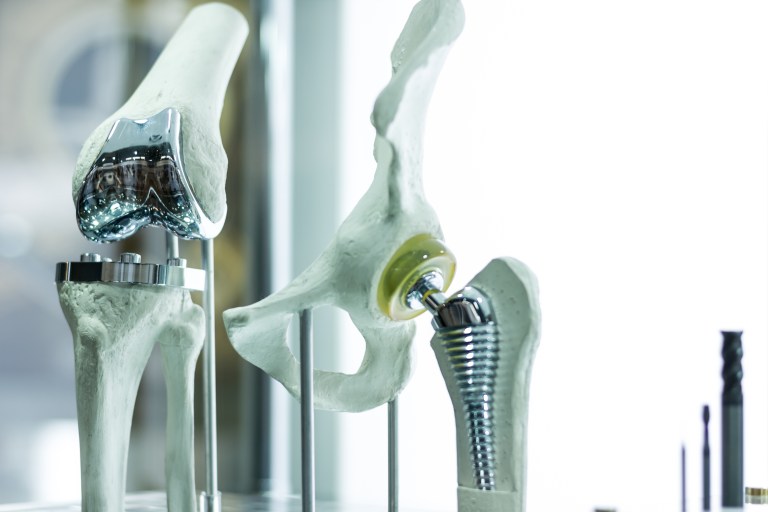
Jul 29, 2021
Paingone
Corticosteroid Injections May Hasten the Need for Joint Replacement
At the Boston University School of Medicine, researchers have indicated that repeated steroid injections to reduce pain and inflammation in joints may actually speed the progression of osteoarthritis and lead to the need for earlier joint replacement surgery.
Lead author and professor of radiology Dr. Ali Guermazi said that the study, focusing on hip and knee joints, showed eight percent of patients developed various complications, including stress fractures, bone deterioration, and cartilage loss within two to 15 months after received steroid injections in the affected joints. The damage was discernable after only one to three injections.
Although corticosteroid injections do bring temporary, quick relief of pain that can last for weeks or months, doctors caution that patients weigh the benefits against potential long-term joint damage that could lead to the need for joint replacement surgery. Alternative pain-relieving methods, including non-invasive measures such as physical therapy, TENS, and exercise are recommended before relying on corticosteroid use.
U.S. Pain Foundation Announces Writing Workshop for Chronic Pain Sufferers
The U.S. Pain Foundation’s ongoing series of events for chronic pain patients is offering a new event on August 3, 2021. The virtual event will focus on how expressive writing can help individuals cope with chronic pain. The moderator, Millie Quinones-Dunlap, has also established “The Writing Room,” a support group for individuals who use writing as a way to deal with ongoing pain. Participants in the forum should have a notebook and pen available for the session’s writing exercise.
The seminar will include the featured speaker as well as a question and answer session. Quinones-Dunlap, the moderator, is a writer and spoken word artist who has been dealing with chronic pain for over sixteen years. She advocates for using expressive writing to overcome the effects of chronic pain and the attending trauma.

If you would like to learn more about “The Writing Room,” visit the U.S. Pain Foundation website.
Australian Study Reveals Link Between Chronic Pain and Changed Brain Chemistry
Australian scientists have discovered that chronic pain may be linked with lower levels of certain neurotransmitters in the brain. This chemical imbalance contributes to the problems many people with chronic pain have when it comes to controlling negative emotions.
While it has long been noted that people suffering from chronic pain have a higher incidence of depression and anxiety, it was most often seen as a reaction to the exhaustion of battling pain. The new study indicates that the inability to monitor and overcome negative emotions has a more complex origin. Long-term pain actually reduces the number of certain neurotransmitters that regulate mood and emotions.
“Chronic pain is more than an awful sensation,” explains Sylvia Gustin, senior author of the new study. “It can affect our feelings, beliefs, and the way we are. We have discovered, for the first time, that ongoing pain is associated with a decrease in GABA, an inhibitive neurotransmitter in the medial prefrontal cortex. In other words, there’s an actual pathological change going on.”
In the study, patients suffering from long-term, chronic pain were shown to have lower levels of GABA, a transmitter associated with emotions. Lower GABA levels result in amplifying certain emotions and thoughts, particularly those linked to negative feelings such as depression and anxiety.
IASP Identifies Unique Pain Category
The International Association for the Study of Pain recognized a new pain classification a few years ago. Still, the term nociplastic pain hasn’t yet become a part of most physicians’ lexicon. For pain sufferers, an understanding of nociplastic pain can lead to improved treatment options, so the IASP is trying to get the word out.
Nociplastic pain results from alteration of the body’s ability to process sensory signals appropriately when there is no evidence of actual tissue damage. With nociplastic pain, peripheral nerve signals leading to the spinal cord are intensified, leading to a dramatic increase in pain levels.
Chronic activation of the pain signals can cause inflammation and reorganization of the neural pathways. The central nervous system becomes hypersensitive, and as a result, individuals experience excruciating pain even when bumps or injuries are minor. Extreme hypersensitivity can lead to conditions such as allodynia, where pain occurs from activities such as brushing your hair or feeling clothing against your skin. The hyper-stimulation of the nervous system spreads from one area of the body to another, which explains why many individuals suffering from chronic pain in one area of their bodies end up with pain spreading to other places.
While pain experts are aware of the impact of nociplastic pain, many general practitioners aren’t aware of or don’t understand the implications of such widespread hyper-stimulation of the nervous system. Because there are no tests to determine the presence of nociplastic pain, it can be challenging to diagnose. The IASP has revised its definition of nociplastic pain. In May of this year, it developed clinical criteria and a pain grading system to ensure proper recognition and improved treatment of chronic pain conditions.
This Week’s Pain Fact: There are ongoing clinical trials for various therapies to treat chronic pain. If you are interested in learning more about clinical trials focusing on chronic pain, you can register at Center Watch, an international organization where you can find and register for appropriate clinical trials.
Is Paingone helping your patients and your practice?
Tell us your success story.
A robust retail strategy is essential to growing your practice.
You only have so many hours a week available for appointments. The fastest way to increase your bottom line is to incorporate profitable products that generate repeat business and build your reputation as a medical professional. That’s where Paingone comes in.
Contact us below to learn more about our products, wholesale pricing and how Paingone can benefit your practice.

